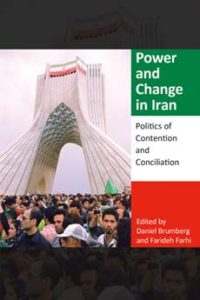
Credit: BPC
One option for countering Iran’s influence in the Middle East would involve highlighting the regime’s domestic vulnerabilities in order to undermine its capacity for regional power projection and show solidarity with Iranians seeking democratic change, according to a new report from the Bipartisan Policy Center’s Task Force on Managing Disorder in the Middle East.
U.S. Policy Towards Iran: Strategic Options offers three strategic policy options to address Iran’s destabilizing regional behavior.
A potential vulnerability is the attitude of the Iranian public toward the regime itself. There is sound basis for believing that there is considerable popular disaffection for the regime, mainly based on the reality of clerical dominance and human rights abuses, the authors observe:
 Some serious scholars are convinced that the contradictions and cruelties of a regime that promises both God’s rule and democracy—and that transparently fails on both counts—will eventually stoke popular anger sufficient to overturn the Islamic Republic.
Some serious scholars are convinced that the contradictions and cruelties of a regime that promises both God’s rule and democracy—and that transparently fails on both counts—will eventually stoke popular anger sufficient to overturn the Islamic Republic. - Others suggested that the opposite may be taking place: that the Iranian public is becoming increasingly demoralized and depoliticized, making popular democratic movements even less likely. With reformists in government failing to deliver and the regime consistently meeting protests with violent force, “fear has caused the Iranian public to see democracy as a luxury that is too costly to afford.”
 Still, Iran’s recent history gives cause for hope, the report suggests.
Still, Iran’s recent history gives cause for hope, the report suggests.
Iran, whether driven by ideological zeal or a strategy of defense in depth, seeks to spread its influence and ultimately its revolution across borders, the it notes.
“Forty years into the Iranian revolution, and Tehran has not abandoned its revolutionary objectives in order to embrace a more traditional state-centered approach to diplomacy,” it adds. “On the contrary, Iran’s investment in sub-state actors [such as Hezbollah and Hamas] is intensifying and diversifying.”
Yet Iran’s efforts to build on its religious ideology to advance its goals, particularly beyond the Shiite world, has shown its limits, the report notes:
Hamas was a key client until its support of the Sunni opposition in Syria led Iran drastically to diminish, if not fully cease, its aid. Over the past year, as Hamas officially distanced itself from the Muslim Brotherhood, Iranian assistance has reportedly been on the rise again. Sudan was a reliable Iranian client/ally for roughly a quarter-century and long served as an important conduit of Iranian arms to Hamas, via the Sinai.
“The challenges Iran has faced in dealing with some of these groups highlight the limits of Islamic ideology and raise an alternative possibility,” the report adds. “While Iran may harbor pan-Islamic regional fantasies, if the primary force behind its regional activities is a more pragmatic desire for defense in depth against foreign powers, then establishing a stable modus vivendi may be possible.”







